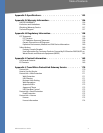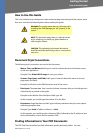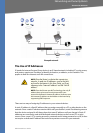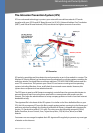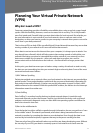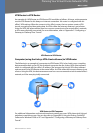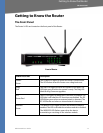
WRVS4400N User Guide 6
An Introduction to LANs
Networking and Security Basics
Networking and Security Basics
An Introduction to LANs
A Router is a network device that connects multiple networks together and forward traffic
based on IP destination of each packet.
The Wireless-N Gigabit Security Router can connect your local area network (LAN) or a group of
PCs interconnected in your home or office to the Internet. You can use one public IP address
from the ISP through WAN port and use the router’s Network Address Translation (NAT)
technology to share this single IP address among all the users.
The Router’s Network Address Port Translation (NAPT or NAT) technology protects your
network of PCs so users on the Internet cannot “see” your PCs. This is how your LAN remains
private. The Router protects your network by inspecting the first packet coming in through the
Internet port before delivery to the final destination on one of the Ethernet ports. The Router
inspects Internet port services like the web server, ftp server, or other Internet applications,
and, if allowed, it will forward the packet to the appropriate PC on the LAN side.
Multiple Wireless-N Gigabit Security Routers can also be used to connect multiple LANs
together. This usually applies to a medium-sized or larger company where you want to divide
your network into multiple IP subnets to increase the intranet throughput and reduce the size
of the IP broadcast domain and its interference. In this case, you need one WRVS4400Nv2 for
each subnetwork and you can connect all the WAN ports to a second level Router or switch to
the Internet. Note that the second level Router only forwards data packets through a wired
network so you don’t have to use the Wireless-N Gigabit Security Router. You can use any wired
router in the Linksys family, e.g. RVS4000, which has 4 LAN ports and 1 WAN port.
The following diagram shows an example that consists of two levels of routers and multiple
LANs inter-connected together. The wireless network is only available at the first level of router
to provide end user connections. The second level router can connect to dedicated Server PCs
or routers that aggregates traffic from different LANs.





